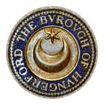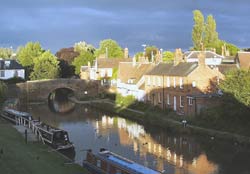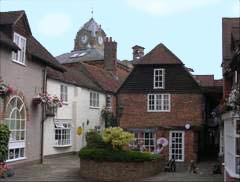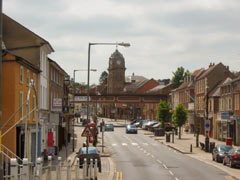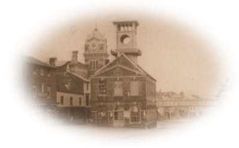A Brief History of Hungerford
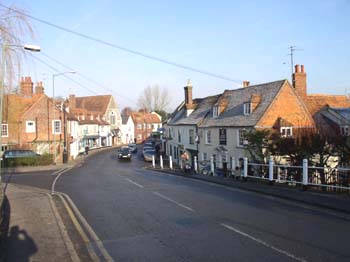 Hungerford appears to be a thriving modern town with Georgian origin. In reality it is much older – a market town with an interesting history.
Hungerford appears to be a thriving modern town with Georgian origin. In reality it is much older – a market town with an interesting history.
Stone Age tools and a Bronze Age building were found in 1989, and a Roman road passes just north of the town. The Domesday Survey of 1086 names many local manors, but not Hungerford itself, and the first written evidence of the town was in 1108, when documents refer to the church of Hungerford being assigned to the Abbey of Bec-Hellouin in Normandy .
The present St Lawrence church was built in 1816, and stands on the site of an Early English predecessor, around which lay the Norman village. Around 1200 a new town plan was conceived, with a main street running north south, and back lanes on either side. The area contained within this framework was divided into narrow burgage plots. This overall structure is still visible today.
Between the 11th and 14th centuries the manor of Hungerford passed between the Crown and various Duchies of Leicester and Lancaster , and in 1362 it passed to John of Gaunt, a name that is strongly associated with the town today.
In 1612 King James I granted the Manor of Hungerford to two local men who in turn passed on the responsibility in 1617 to a group of 14 men as feoffees or trustees. The present commoners are those people owning and living in the properties established at the time of the 1612 James I grant.
The organisation of the Town and Manor of Hungerford has remained little changed for nearly 400 years. Office holders include the Constable, the Port-Reeve, Bailiff, four Tutti-men, a number of Water-Bailiffs, several Overseers of the Common (Port Down), three Keepers of the Keys of the Common Coffer, two Ale-Tasters (or 'Testers'), and the Bellman and Assistant Bailiff. Some offices have fallen from usage, including the Searchers and Sealers of Leather, and the Tasters of Flesh and Fish!
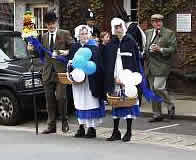 Hungerford's most important day is Tutti-Day (the second Tuesday after Easter), which marks the end of the financial and administrative year. The Bellman (who is also Town Crier) summons the Commoners to the Court, while the two Tutti-men work their way around the town, visiting every house with common rights, numbering nearly 100 in total. In the past they would have collected the 'head penny' from each householder, but nowadays the most they collect is a kiss from the ladies of the house, and a little hospitality to help them on their way. In Court the officers are elected for the coming year, the accounts are read and agreed, and a number of other matters are discussed concerning the affairs of the Town and Manor. In 1908 the Town and Manor became a registered charity, and is thus responsible to the Charity Commissioners. The present trustees arid court have a considerable responsibility, managing the Town Hall, the John of Gaunt Inn, the Common, Freemen's Marsh, as well as the extensive fishing in the Rivers Kennet and Dun.
Hungerford's most important day is Tutti-Day (the second Tuesday after Easter), which marks the end of the financial and administrative year. The Bellman (who is also Town Crier) summons the Commoners to the Court, while the two Tutti-men work their way around the town, visiting every house with common rights, numbering nearly 100 in total. In the past they would have collected the 'head penny' from each householder, but nowadays the most they collect is a kiss from the ladies of the house, and a little hospitality to help them on their way. In Court the officers are elected for the coming year, the accounts are read and agreed, and a number of other matters are discussed concerning the affairs of the Town and Manor. In 1908 the Town and Manor became a registered charity, and is thus responsible to the Charity Commissioners. The present trustees arid court have a considerable responsibility, managing the Town Hall, the John of Gaunt Inn, the Common, Freemen's Marsh, as well as the extensive fishing in the Rivers Kennet and Dun.
In 1688 a very important part of British history took place in Hungerford. Prince William of Orange , having landed at Brixham in Devon , travelled with his army towards London . King James II sent three commissioners to meet Prince William, and the meeting took place in the Bear Inn at Hungerford on 6 December 1688 , and plans were made for the throne of England to pass to William.
The very fact that such a crucial meeting took place in Hungerford is evidence of the importance of the London to Bath Road . The Bath Road had a considerable effect on the town's growth and development. Coaching became big business, and during the hey-day of the coaching period the town grew and prospered, with many coaching inns around the town, as well as stables and blacksmiths. Many of the timber-framed High Street properties were 'modernised' by the addition of new Georgian frontages.
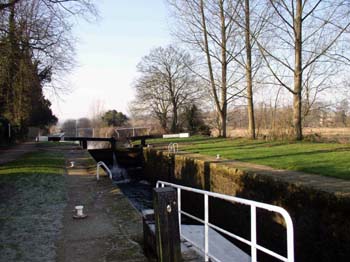 The prosperity of the town was further enhanced by the opening of the Kennet and Avon Canal in 1810. Hungerford wharf brought valuable business to the town, but the opening of Brunel's Great Western Railway to Bristol in 1841 spelt disaster to the canal trade. Journeys that had taken more than a week by canal could now be accomplished in just a few hours. Both the canal trade and coaching traffic slumped. The railway came to Hungerford in 1847, and the line was later extended onwards to the west, but the expected prosperity failed to materialise, and the population actually fell between 1851 and 1901.
The prosperity of the town was further enhanced by the opening of the Kennet and Avon Canal in 1810. Hungerford wharf brought valuable business to the town, but the opening of Brunel's Great Western Railway to Bristol in 1841 spelt disaster to the canal trade. Journeys that had taken more than a week by canal could now be accomplished in just a few hours. Both the canal trade and coaching traffic slumped. The railway came to Hungerford in 1847, and the line was later extended onwards to the west, but the expected prosperity failed to materialise, and the population actually fell between 1851 and 1901.
Despite the many problems in the late Victorian period, a new Town Hall and Corn Exchange were built, and several new churches. Two important iron foundries provided employment for many men in the town. The Hungerford Water Works was established in 1903, and mains drainage in 1909. Telephones were installed in 1907, a splendid new Council School was built in 1910, and a new post office in 1914.
The outbreak of the First World War had a profound effect on the town. Many men went to fight, whilst the town itself was host to an army unit assembling here before joining the front.
The years after the First World War saw the town begin its great 20th-century expansion, with much new building. This was also a time of great community spirit, with a strong emphasis locally on sports and games. A sports ground in The Croft was opened in 1921, and bowls, croquet, tennis, shooting, rugby, football and cricket all thrived. There was even a golf course on the Common.
The building of the M4 motorway in 1971 brought further prosperity to the whole Kennet Valley . The Kennet and Avon Canal was restored at Hungerford in 1974, and fully reopened in August 1990. It provides enjoyment for many, whether in boats or on the tow-path. Modern Hungerford is well known for its antique shops, and as a tourist centre.
More information on the history of Hungerford can be found on the Hungerford Historical Association website www.hungerfordhistorical.org.uk
© Dr. Hugh Pihlens
Hungerford Virtual Museum
|
||||
The Bellman of Hungerford
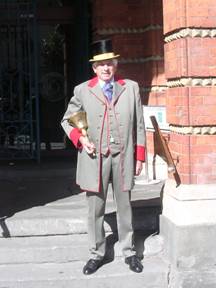 One of the longstanding traditions of Hungerford is that of appointing a BELLMAN (TownCrier) , who also holds the several offices of Assistant Bailiff, Beadle, and Crier for the Hocktide Courts, in former times was also lessee of the "Towne Shoppe"
One of the longstanding traditions of Hungerford is that of appointing a BELLMAN (TownCrier) , who also holds the several offices of Assistant Bailiff, Beadle, and Crier for the Hocktide Courts, in former times was also lessee of the "Towne Shoppe"
Robin Tubb held the post until his death on 3 Jan 2012. He was the fourth generation of his family to hold the post, following his Great Grandfather, appointed 1880, Great Uncle 1923, and Mother 1956. Robin was appointed in 1957, thereby making him the longest serving crier in the world. We wait to see who will be appointed as his successor.
The Bellman can be seen on many occasions perambulating the Town in his grey and hunting pink regalia, with black silk gold laced hat, carrying his bell or beadles pole, exercising his many duties, from delivering messages and communications, to leading Church and other parades, as well as making proclamations on behalf of the Traditional, Civic, Charitable, or indeed any other organisation, who can engage his vocal services.
Visitors to the Town are welcome to let themselves be known to the Bellman, should they encounter him in the street, whether they be passing through, or here on a longer stay. He may be of help or of interest, having a wealth of local knowledge.
